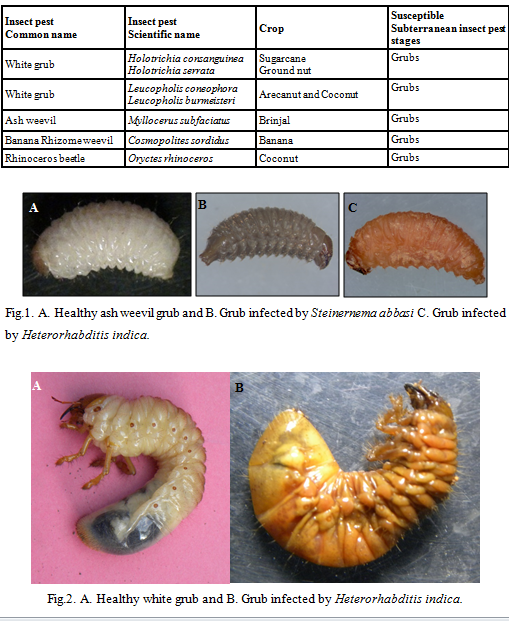Authors: Manjunatha T Gowda1, Jagadeesh Patil2, Sellaperumal C1, A.B. Rai1 and B. Singh1
1Working as Research Scientist at ICAR- Indian Institute of Vegetable Research, Varanasi
2Working as Research Scientist at ICAR- National Bureau of Agricultural Insect Resources, Bengaluru
Nematodes are triploblastic, bilaterally symmetrical, unsegmented, psuedocoelomate animal. Among vast diversity of nematodes, some have evolved an association with insect pathogenic bacteria. Together the bacteria and nematode are lethal obligatory parasites capable to infect many above ground and subterranean life stages of insect pests. These nematodes are called as ‘entomopathogenic nematodes’.
Entomopathogenic nematodes (EPN) are in the species of Heterorhabditis spp. (Heterorhabditidae) and Steinernema spp. (Steinernematidae) symbiotically associated with the bacteria of the genera Photorhabdus and Xenorhabdus (Enterobacteriacae), respectively. These nematodes occur in soil habitats and have been isolated from most regions of the world (Kaya and Gaugler, 1993). EPNs fit nicely into integrated pest management (IPM) programs because they are considered non-toxic to humans, relatively specific to their target pest(s), and can be applied with standard pesticide equipment (Shapiro-Ilan et al. 2006).
Pathogenicity
In a mass of soil complex, infective juveniles, a free-living stage of EPN penetrate to insect hosts through natural openings (mouth, anus, and spiracles) or directly through the cuticle. After penetration into the hemocoel, each infective juvenile releases the mutualistic bacteria. The symbiotic bacteria release toxins, exoenzymes and other metabolites to kill the insect host within 24 to 48 h after infection. The bacterial symbiont digests the host tissues, thereby providing suitable nutrient and environment for nematode growth and development.
Life cycle
The life cycle of steinernematids and heterorhabditids includes egg stage, four juvenile stages and an adult stage. The third juvenile stage denoted as infective juvenile or dauer stage. The infective juvenile is only free living stage and also has ability to survive in the soil where it locates, attacks and infects an insect pest (Poinar, 1990). Steinernematids and heterorhabditids take 3-7 days for to complete one life cycle inside host from egg to egg under optimal conditions. Emergence of infective juveniles from host requires about 6-11 days for steinernematids and 12-14 days for heterorhabditids (Kaya and Koppenhofer, 1999).
Beneficial traits
• Highly virulent in killing host within 24-48 hours.
• Easy to mass produce on Galleria mellonella host.
• High reproductive potential.
• Potential to recycle in the environment.
• Broad host range.
• Safe to human, plant, animal and earthworms.
• Compatible with many chemical insecticides.
Table 1: Susceptibility of major subterranean insect pests to entomopathogenic nematodes

Effect of abiotic factors on efficacy
Entomopathogenic nematodes are extraordinarily versatile in being useful against subterranean insect pests in diverse cropping systems. However, nematodes are constrained by abiotic factors like temperature, moisture, desiccation or ultraviolet light. These factors rapidly inactivate pathogenicity of nematodes and reduced their efficacy when compared with chemical insecticides. On the other hand the use of EPN’s based formulations requires additional knowledge on nematode biology, ecology as well as time and method of field applications.
Commercialization
In recent times technological advances in nematode production, formulation, quality control, application timing and delivery and particularly in selecting optimal target habitats and target pests have narrowed the efficacy gap between chemical insecticides and EPNs. In this regard ICAR- National Bureau of Agricultural Insect Resources (NBAIR) Bengaluru developed a technology on novel insecticidal wettable powder (WP) formulations of Heterorhabditis indica for the biological control of white grubs and other soil insect pests. This WP formulation of EPNs is effective for controlling a variety of subterranean life stages of insect pests (Table1), in particular especially true for white grubs. They commercialize the product through technology transfer agreement with many private and public organizations to make available to farmers.
Application methods
Commercially available wettable powder (WP) formulation can be applied to soil through broad cast or spot application or also by using standard irrigation systems. Before application, 6-8 kg/acre of WP formulation mixed with 100 kg of any organic manure or compost or vermiculite or coir pith or moist sand. Apply this mixture as broad cast or spot application followed by a light irrigation in case soil is dry. Even WP formulation can be applied through drip irrigation.
Conclusions
In the present context of food and environmental safety, biological and non-chemical approaches for the management of insect pests are need of the hour. In this regard EPN’s would be excellent biocontrol agents for the management of variety of insect pests and also one of the most efficient alternatives to chemical insecticides.
References:
1. Kaya, H.K & Koppenhofer A.M (1999). Biology and Ecology of Insecticidal Nematodes. In Workshop Proceedings: Optimal Use of Insecticidal Nematodes in Pest Management, pp. 1â€"8.
2. Poinar, G.O (1990). Taxonomy and biology of Steinernematidae and Heterorhabditidae. In: Gaugler, R & Kaya, H.K (Eds.). Entomopathogenic Nematodes in Biological Control CRC Press, Boca Raton., Florida. pp. 23-61.
3. Gowda, M. T., Patil, J., Devindrappa M., Vijayakumar R & Abraham Verghese (2016). Entomopathogenic nematodes: a potential biocontrol agent against eggplant ash weevil Myllocerus subfaciatus Guerin (Coleoptera: Curculionidae). Nematology (18) 743-750.
About Author / Additional Info: